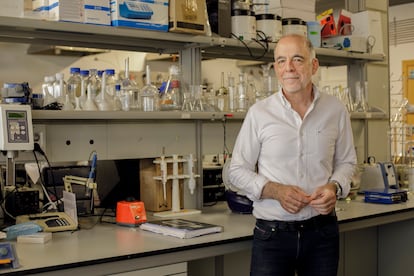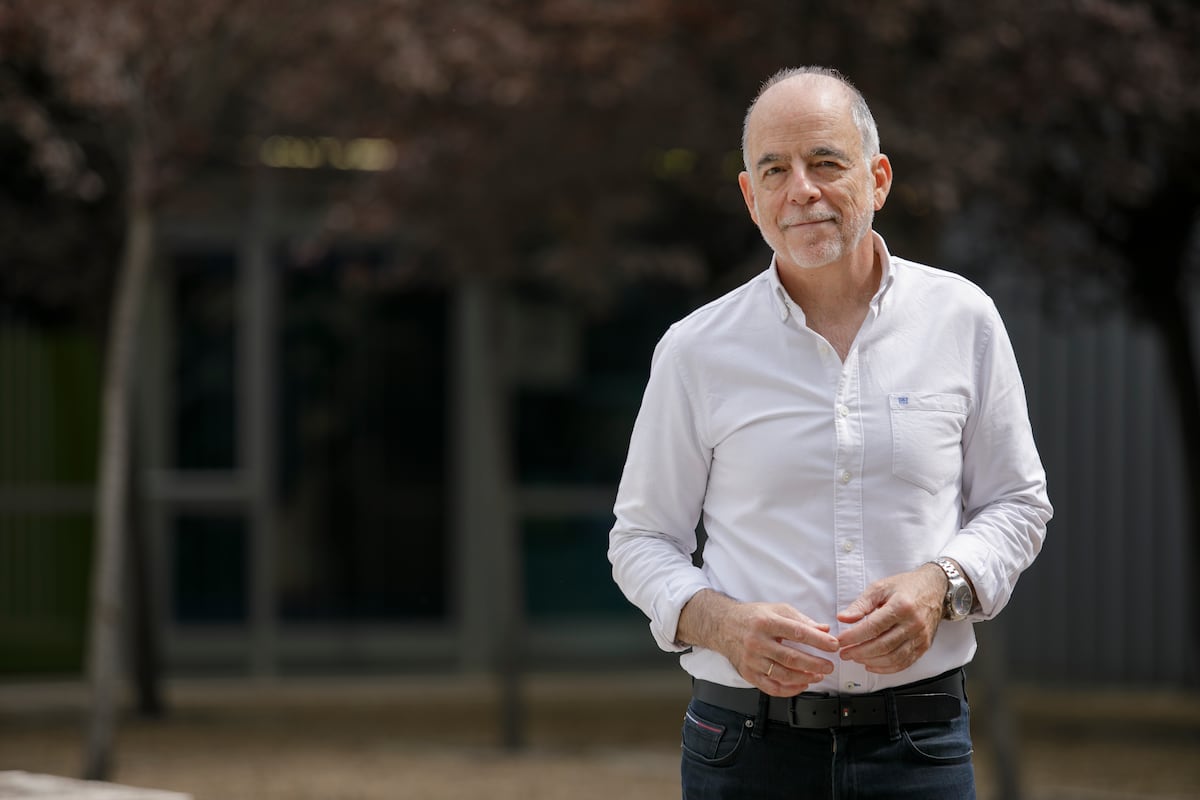Chemical engineer Jesús Santamaría believes that scientists are capable of better murders. “They are accustomed to observing, drawing conclusions. They can understand a detective’s deductive process, and so the crimes they are able to commit are more interesting, harder to solve,” he says.
— Do you think that you would know how to kill a person better?
— Of course. Definitely, definitely.
Santamaría, 66, is of a distinctive profile. He is writing his third Spanish-language crime novel, about a scientist who is a serial killer, and has received more than $5.8 million from the European Research Council towards trying to cure cancer. Killing a person is easy on paper, but killing off just a part of their cells, the cancerous ones, is the great challenge of medicine. Santamaría says that the year of his birth, 1959, was also when celebrated U.S. physicist Richard Feynman gave a talk now considered a foundational text of nanotechnology, the manipulation of matter down to millionths of a millimeter. Feynman, one of the fathers of the atomic bomb, mentioned “a very crazy idea” of a friend of his. “It would be interesting in surgery if you could swallow the surgeon. You put the mechanical surgeon inside the blood vessel and it goes into the heart and ‘looks’ around. It finds out which valve is the faulty one and takes a little knife and slices it out,” mused the physicist.
That idea ceased being regarded as crazy a long time ago, explains Santamaría in his office at Spain’s Nanoscience and Materials Institute in Zaragoza. The first FDA-approved nanomedicine, which is called Doxil, has been used since 1995 to treat various kinds of cancer. It’s simply a chemotherapy compound — doxorubicin, obtained from bacteria — that is encapsulated in fat spheres. The resulting molecules are small enough to circulate in the blood until they encounter the characteristic pores of a tumor’s blood vessels, which are malformed due to the rapid growth of the cancer. With a simple nanotechnology trick, the medicine reaches diseased areas more accurately.
“It’s just 30 years since the first nanomedicine. People at the time thought, ‘This is awesome, we’ve beaten cancer! If a silly passive system can achieve that, what can’t we achieve attaching medicine to monoclonal antibodies [proteins created in the laboratory to target cancer cells directly]?’ And what has happened since then? The drug doesn’t reach the cells,” says Santamaría.
German chemist Stefan Wilhelm took measure of the magnitude of this failure in 2016. After revising all the studies published over the prior decade, he observed that only 0.7% of the dose of nanoparticles injected into a patient actually got to the tumor. Apparently excellent nanopharmaceuticals existed to kill cancerous cells, but they weren’t arriving at their destination. “That’s the Gordian knot. If we solve it, we’ve got it,” says Santamaría. The European Research Council just awarded him one of its Advanced Grants, $3.6 million to go toward finding this quandary’s solution. It is his third such European grant, a milestone that only five other scientists in Spain have achieved.
The researcher presented his first crime novel, Akademeia, in 2018. In it, a young Spanish scientist emigrates to the United States to work at the Massachusetts Institute of Technology and encounters a ruthless battle of egos and a dead body. “Scientists are often seen as benevolent beings, dedicated to their exotic investigations, removed from mundane passions. But researchers are human beings, subject to the same passions as the rest, and capable of the same abuses,” warns the author on the book’s back cover.
During the Covid lockdown, Santamaría wrote his second crime novel, Inmortal, in which once again the protagonist was a Spanish researcher at MIT who comes across a messianic scientist who has founded a new religion and is seeking immortality. “They are pure and simple crime novels. No one should expect deaths on the first page. When I kill someone, you already understand the murderer perfectly and you also agree that they should kill,” says the author, cackling.
It’s no coincidence that the scene of these crimes is MIT, one of the temples of global science. Santamaría got into politics for the government of the Spanish region of Aragón in 2003, as director-general of research in the administration of the Spanish Socialist Workers’ Party’s Marcelino Iglesias. In 2007, after leaving that position, he took a sabbatical year at MIT under the guidance of Robert Langer, the guru of smart drug delivery and one of the world’s greatest inventors of medicines. In 2010, Langer and other colleagues founded Moderna, which would go on to produce one of the first effective vaccines against Covid and save millions of lives.

With the $2.18 million from his first European grant in 2011, Santamaría’s team developed catalysts for the hydrocarbon industry. With his nearly $2.9 million second grant in 2017, they produced other catalysts that, when activated, generate toxic substances in cancer cells to destroy them from within, leaving them without their food. “They are real glucose junkies,” says the scientist. That nullifies their essential antioxidant molecules, supplying them with inactivated drugs that can be reactivated at will. Santamaría says that results in mice have been promising, even though when the animals are sacrificed after each experiment, it is revealed that up to 98% of the nanoparticles are trapped in the liver and do not reach the tumor.
With his third, $3.6 million grant, Santamaría is facing off with that Gordian knot: the patient’s own immune system. The immense majority of nanoparticles wind up being captured by the white blood cells in the liver’s blood vessels. His team’s initial strategy was to design innocuous decoys that distract the white blood cells before injecting the healing nanoparticles. Once these human defenses have been evaded, the tumor may be reached. “Our next strategy is that of the Trojan horse,” he says, referencing the legend of the seemingly harmless wooden equine that gains access into a fortified city, only for its residents to discover that the steed is full of Greek soldiers.
Tumor cells communicate through extracellular vesicles measuring millionths of a millimeter across. Santamaría and his colleagues’ ultimate goal is to take a sample of a patient’s cancer, cultivate their tumor cells in a laboratory, extract the vesicles, load them with healing nanoparticles, and re-inject them into the patient after administering the decoy particles. “We want to test the concept on a mouse with a complete immune system. If it works, and instead of 1% of the nanoparticles reaching the tumor, 50% do, there will be cries of joy in Madrid. If we succeed, we will look for a pharmaceutical company that wants to participate in human clinical trials,” says Santamaría, who is also a professor at the University of Zaragoza.
The scientist is in the process of finishing his third crime novel, which is once again set at MIT. On this occasion, the Spanish researcher is unjustly expelled from the school, and decides to get his revenge, becoming a serial killer of scientific journal editors. The nanotechnologist from Burgos imagines innovative ways to kill in his spare time, but he devotes his working day to finding the key to exterminating only a person’s undesirable cells, thereby saving their life. “It would be the realization of Feynman’s dream in 1959: reducing the size of the doctor so that they could enter our body, look around for things to repair, and repair them,” he says.
Sign up for our weekly newsletter to get more English-language news coverage from EL PAÍS USA Edition
